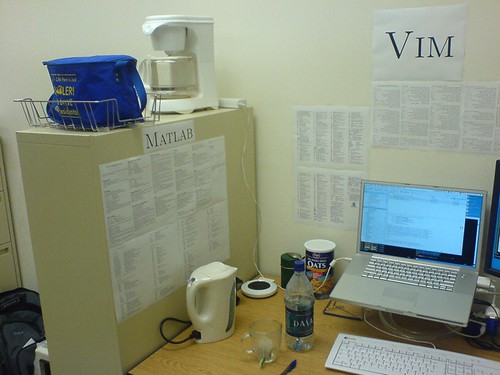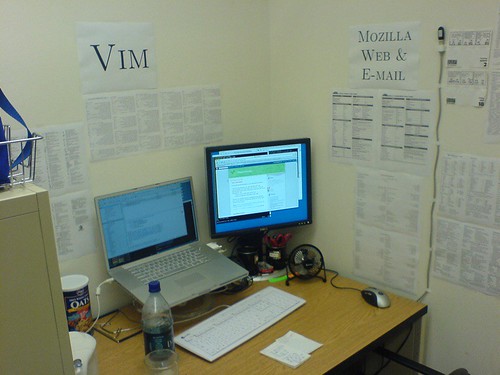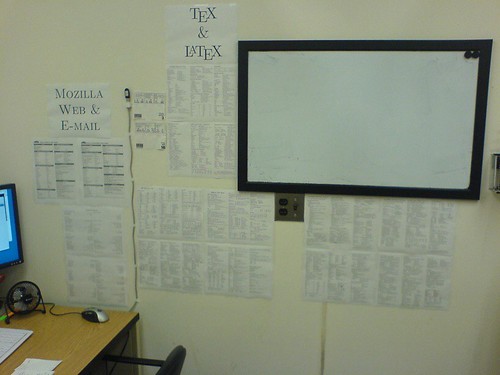UPDATE 3: If it doesn't seem like commands are launching from within Vim, check out my post on setting PATH in Vim. In particular, if you are using the nascent MacVim, checking the "Launch Vim processes in a login shell" preference may fix your problems.
UPDATE 2: I've updated the patch file to fix a few bugs in my original implementation (thanks to Ross M. Richardson for the help!). This version supports forward searching from multi-file projects. By the way, if you didn't know, if you have a project with multiple files where the main LaTeX document is called my_latex_file.tex, you should create a dummy file called my_latex_file.latexmain in the same directory. That way, VIM-LaTeX will know to run its compiler and viewer on the main file and not on any of the smaller constituent files.
UPDATE 1: Skim 0.6 and up supports spell checking of a PDF. This is a strange feature of a PDF viewer since Skim does not allow you to edit the PDF text directly. However, it makes a lot of sense when inverse searches are supported. After doing Shift+Command+CLICK on the misspelled word, the TeX editor will open up near the line of TeX where the word is found.
I have already commented on doing
inverse searches (or backward searches) in Vim on OS X. However, I have not handled forward searches.
Ross M. Richardson offers a
hack for doing forward searches into PDFView; however, it's clear that while this is a hack it is certainly not a
lifehack. What I really want is a version of
VIM-LaTeX that supports using
PDFView,
Skim,
TeXniscope, or any UNIX shell script as a forward-search-compatible viewer.
The
script I presented in
an earlier post makes backward searches compatible in nearly any PDF/DVI viewer. Now, I just need to hack
compiler.vim to do the reverse. I did this by modifying the
Tex_ViewLaTeX and
Tex_ForwardSearchLaTeX functions from the
20060325 release of VIM-LaTeX. You can find my changes in
VIM-LaTeX-osx-inverse-search-compiler.patch. To apply the patch, go into your
~/.vim/ftplugin/latex-suite/ directory, backup your old
compiler.vim file, and try
patch -p0 < VIM-LaTeX-osx-inverse-search-compiler.patch
Of course, you should either drop the patch file into that directory or change the
patch command so it has the full path to the patch. Now, all you need to do is configure your
~/.vimrc and you'll be able to use
\lv for viewing and
\ls for forward searches.
OS X Applications: Say that I want to use
Preview to view PostScript files,
TeXniscope to view DVI files, and
Skim to view PDF files (note that both TeXniscope and Skim can open all of these, but only TeXniscope supports DVI source specials). In that case, I could put these lines in my
~/.vimrc file:
let g:Tex_ViewRule_ps = 'Preview'
let g:Tex_ViewRule_pdf = 'Skim'
let g:Tex_ViewRule_dvi = 'TeXniscope'
Now, VIM-LaTeX will use these whenever
\lv (for viewing) or
\ls (for forward search) are used. That's right, it will do
forward searches with these OS X applications (well,
Skim and
TeXniscope)! That's easy enough.
UNIX Viewer Scripts: Now, let's say I wanted to use the
skim and
texniscope scripts that I built earlier. In this case, I use the following in my
~/.vimrc file:
let g:Tex_TreatMacViewerAsUNIX = 1
let g:Tex_ExecuteUNIXViewerInForeground = 1
let g:Tex_ViewRule_ps = 'skim'
let g:Tex_ViewRule_pdf = 'skim'
let g:Tex_ViewRule_dvi = 'texniscope'
That
g:Tex_TreatMaxViewerAsUNIX tells VIM-LaTeX not to use
open -a to open the viewer. The
g:Tex_ExecuteUNIXViewerInForeground gets rid of the
& appended to the end of the execution strings used by VIM-LaTeX. For some reason, this option needs to be set to get UNIX viewers to work in MacVim.
Empty Viewer Scripts and Other Stuff: As before, if those
ViewRule variables are set to empty values (i.e.,
''),
open -a will be used. On the other hand, if
g:Tex_TreatMacViewerAsUNIX is set,
VIM-LaTeX will act like it does on a UNIX machine, and
xdvi,
xdvik, and
kdvi can be used. These three DVI viewers are handled specially. Any other UNIX script should follow the convention:
script "%target_file" %line "%source_file"
where
script is the UNIX command,
%target_file is the main PDF, PS, or DVI file to open, and
%line is the line in the TeX source file
%source_file for forward searching (i.e., using
\ls). If
\lv is being used, the
%line and
%source_file parts are omitted.







